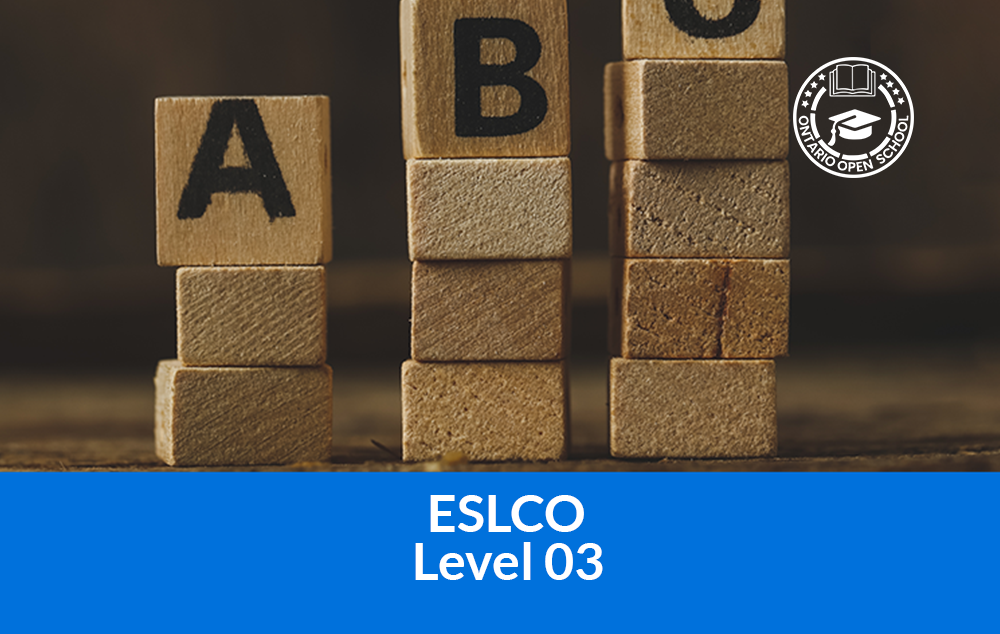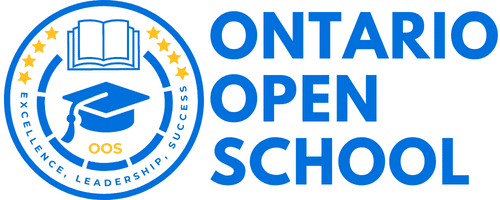- info@ontarioopenschool.com
- 647-494-4499
-
Unit 100 - 29 Gervais Drive, North York, ON.
M3C 1Y9
Copyright 2024 Ontario Open School Inc. All Rights Reserved.
This course further extends students’ skills in listening, speaking, reading, and writing in English for a variety of everyday and academic purposes. Students will make short classroom oral presentations; read a variety of adapted and original texts in English; and write using a variety of text forms. As well, students will expand their academic vocabulary and their study skills to facilitate their transition to the mainstream school program. This course also introduces students to the rights and responsibilities inherent in Canadian citizenship, and to a variety of current Canadian issues.
Unit Order | Unit Name | Suggested Time |
|---|---|---|
| Unit 1 | Open Secrets: Short Stories This unit covers the following strands: Listening and Speaking, Reading, Writing, Socio-Cultural Competence and Media Literacy Overall Expectations: 1, 2, 3, 4, 5, 6, 7, 8, 9, 10, 12, 15 | 28 hours |
| Unit 2 | The Dynamics of Canada: Coming to an Understanding of Canada This unit covers the following strands: Listening and Speaking, Reading, Writing, Socio-Cultural Competence and Media Literacy Overall Expectations: 1, 2, 3, 4, 5, 6, 7, 8, 9, 10, 11, 12, 13, 14, 15 | 27 hours |
| Unit 3 | Naomi’s Road: Investigating A Novel This unit covers the following strands: Listening and Speaking, Reading, Writing, Socio-Culural Competence and Media Literacy Overall Expectations: 1, 2, 3, 4, 5, 6, 7, 8, 9, 10, 12, 15 | 27 hours |
| Unit 4 | Talking to Canadians: Coming to Terms with Canadian Society This unit covers the following strands: Listening and Speaking, Reading, Writing, Socio-Culural Competence and Media Literacy Overall Expectations: 1, 2, 3, 4, 5, 6, 7, 8, 9, 10, 12, 15 | 20 hours |
| Final Evaluation 30% | Summative Evaluation Final Exam This unit covers the following strands: Listening and Speaking, Reading, Writing, Socio-Cultural Competence and Media Literacy Overall Expectations: 1, 2, 3, 4, 5, 6, 7, 8, 9, 10, 11, 12, 13, 14, 15 | 6 hours 2 hours |
| Total | 110 Hours |
A variety of strategies are used to allow students many opportunities to attain the necessary skills for success in this course. The teacher uses a variety of whole class, small group and individual activities to facilitate learning. The following is a list of specific teaching/learning strategies that the teacher may use but is not limited to:
Purpose
The primary purpose of assessment is to improve student learning. Assessment relates directly to the expectations for the course.
A variety of assessments for and as learning are conducted on a regular basis to allow ample opportunities for students to improve and ultimately demonstrate their full range of learning and for the teacher to gather information to provide feedback. Assessment tasks relate to the success criteria set out in lesson plans. Success criteria allow students to see what quality looks like.
Evaluation is the process of judging the quality of student work in relation to the achievement chart categories and criteria and assigning a percentage grade to represent that quality. Evaluation is based on gathering evidence of student achievement through:
Assessment for Learning – we provide feedback and coaching. Assessment FOR Learning is the process of seeking and interpreting evidence for the use of learners and their teachers to decide where the learners are in their learning, where they need to go, and how best to go there.
Assessment as Learning – we help students monitor progress, set goals, reflect on their learning
Assessment AS Learning is the process of the explicit fostering of students’ capacity over time to be their own best assessors, but teachers need to start by presenting and modeling external, structured opportunities for students to assess themselves.
Assessment of Learning – we use assessments to provide evaluative statements about student achievement. Assessment OF Learning is the assessment that becomes public and results in statements of symbols
(marks/grades/levels of achievement) about how well students are learning. It often contributes to pivotal decisions that will affect students’ future.
ASSESSMENT TOOLS
Unit 1:
| Assessment For Learning (AFL) | K/U | T | C | A |
| Class Discussions | X | X | X | X |
| Group Activity Participation | X | X | X | |
| Story retell | X | X | ||
| Response Journals | X | X | X | |
| Graphic Organizer | X | X | X | |
| Character/Setting Sketch | X | X | ||
| Pre-Tests
Quizzes Rough Drafts |
X |
X
X |
X |
X
X |
| Assessment As Learning (AAL) | ||||
| Conferencing | X | X | ||
| Self-Assessment | X | X | X | |
| Vocabulary Quiz | X | X | X | |
| Entrance Tickets
Exit Tickets Questionnaires |
X
X |
X |
X
X |
X X |
| Assessment Of Learning (AOL) | ||||
| Story-Telling | X | X | X | X |
| Test
Reports/response (rubric) Final Reflection |
X
X |
X
X X |
X
X |
X
X |
Unit 2:
| Assessment For Learning (AFL) | K/U | T | C | A |
| Brainstorming | X | X | X | |
| Vocabulary List | X | X | X | |
| Response Journals | X | X | X | |
| Exit Ticket | X | X | ||
| Peer-feedback (anecdotal/checklist) | X | X | X | X |
| 5W’s Answers | X | X | ||
| Paragraph-Writing | X | X | X | |
| Assessment As Learning (AAL) | ||||
| Peer Assessment | X | X | X | |
| Self-Assessment | X | X | X | |
| Quiz
Rough drafts |
X
X |
X
X |
X | |
| Assessment For Learning (AFL) | ||||
| Province Presentation | X | X | X | X |
| Expository Paragraph | X | X | X | X |
| Test | X | X | X | X |
Unit 3:
| Assessment For Learning (AFL) | K/U | T | C | A |
| Anticipation Questions | X | X | ||
| Graphic Organizers | X | X | ||
| Character Sketch | X | X | X | |
| Literature Circle Activities | X | X | X | X |
| Response Journals | X | X | X | |
| Business Meeting Role Play (script) | X | |||
| Assessment As Learning (AAL) | ||||
| Self-Assessment | X | X | ||
| Peer-Assessment | X | X | ||
| Quiz | X | X | X | X |
| Assessment For Learning (AFL) | ||||
| Completion of Literature Circle Roles/Activities | X | X | X | X |
| Role Play (Rubric) | X | X | X | X |
| Interview | X | X | X | X |
Unit 4:
| Assessment For Learning (AFL) | K/U | T | C | A |
| Reading Activities | X | X | ||
| Media – Listening Comprehension and Discussion | X | X | X | |
| Graphic Organizers | X | X | X | X |
| Interview Questions – Draft | X | X | ||
| Rough drafts | X | X | ||
| Assessment As Learning (AAL) | ||||
| Peer Editing | X | X | X | X |
| Self-Editing/Assessment | X | X | X | X |
| Assessment For Learning (AFL) | ||||
| Interview – Final Copy | X | X | X | X |
Resources
English, YES! Level 1: Basic (McGraw-Hill)
English, YES! Level 2: Introductory (McGraw-Hill)
English Yes! Level 3: Beginning Student Text: Learning English Through Literature
English Yes! Level 4: Intermediate A Student Text: Learning English Through Literature
Language Handbook: Support for the Language Handbook, Harcourt Education (Holt, Rineheart and Winston)
Growing Success: Assessment Evaluation and Reporting in Ontario Schools, First Edition Covering Grades 1-12
Grading
Weighting of categories
| Knowledge/Understanding | Thinking/Inquiry | Communication | Application |
| 25% | 25% | 25% | 25% |

Course Grade | ESL |
|---|---|
Course Code | ESLCO |
Course Category | English As a Second Language (ESL) |
Course Type | Open |
Course Delivery | Online |
Course Duration | 110h |
Course Credit | 1.00 |
Copyright 2024 Ontario Open School Inc. All Rights Reserved.
